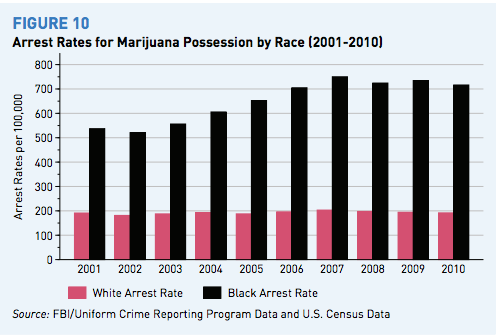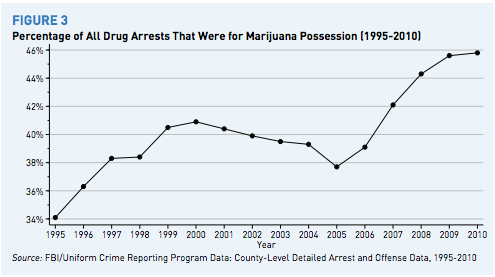The War on Pot Is Both Insanely Racist and Insanely Expensive, New Report Says
There's a county in the U.S. in which blacks make up 12% of the population and 100% of the marijuana arrests.

Across the United States--north, east, south, west--blacks are more likely than whites to be arrested for marijuana possession. That's the conclusion of a new ACLU report that compares arrest data from 945 counties across the country.
"In 2010, the Black arrest rate for marijuana possession was 716 per 100,000, while the white arrest rate was 192 per 100,000," the ACLU says. That national disparity is reflected (to varying degrees) at the local level, "regardless of whether Blacks make up 50% or 5% of a county's overall population." Blacks were more likely than whites to be arrested for pot in 908 of the 945 counties for which the ACLU crunched data. And that disparity--as you can see in the chart at right--has actually gotten worse over the years.
It's no secret that in big cities like D.C. and New York blacks are arrested for pot far more often than whites, despite comparable usage rates. But the ACLU is the first group to extrapolate arrest numbers across the country. The picture it paints is depressing:
In Lycoming and Lawrence, PA, and in Kenton County, KY, Blacks make up less than 5% of the population, but are between 10 and 11 times more likely than whites to be arrested. In Hennepin County, MN (includes Minneapolis), and Champaign and Jackson Counties, IL, Blacks are 12%, 13%, and 15% of the population, respectively, but are 9 times more likely to be arrested than whites. In Brooklyn, NY, and St. Louis City, MO, Blacks comprise 37% and 50% of the residents, respectively, and are 12 and 18 times more likely to be arrested than whites. In Chambers, AL, and St. Landry, LA, Blacks account for more than twice as many marijuana arrests (90% and 89%, respectively) than they do of the overallpopulation (39% and 42%, respectively). In Morgan and Pike Counties, AL, Blacks make up just over 12% and 37% of the population, respectively, but account for 100% of the marijuana possession arrests.
Yes, there's a county in the U.S. in which blacks make up 12 percent of the population and 100 percent of the marijuana arrests. The drug war is racist as hell. Just look at these charts:

The war on pot is also an insane misuse of resources:
- The ACLU estimates the total national expenditure of enforcing marijuana possession laws at approximately $3.613 billion. In 2010, states spent an estimated $1,747,157,206 policing marijuana possession arrests, $1,371,200,815 adjudicating marijuana possession cases, and $495,611,826 incarcerating individuals for marijuana possession.
- New York and California combined spent over $1 billion to enforce their marijuana laws in 2010. Add the amount of money that Texas, Illinois, Florida, New Jersey, Georgia, and Ohio spent, and the total is over $2 billion.
- Over half of the states (27) each spent over $30 million in 2010 enforcing marijuana possession laws.
- Even when discounting entirely all state ?scal spending on prison facilities, corrections expenditures associated with marijuana possession enforcement are signi?cant — California, Florida, Illinois, New York, and Texas, for example, each spent more than an estimated $20 million of state taxpayer money in 2010 housing individuals in local jail and county correctional facilities for possession of marijuana, with New York and California spending more than $65 million apiece.
The report also singles out the number of arrests for marijuana possession in relation to other drugs and drug crimes, which nets us this insane graph:

The local focus on pot is being driven by federal Byrne Justice Assistance Grants (for which Pres. Obama has restored funding after a dip during the Bush years):
JAG does not restrict the categories of arrests in its performance measures to felonies or serious drug cases. Rather, all drug arrests, including misdemeanors (such as for marijuana possession), must be reported tothe BJA as a condition of receiving federal funds.140 Because JAG does not limit the categories of arrests in its performance measures to felony arrests, or arrests for more serious drug offenses — as one would expect given the program's original purpose of ?ghting serious, violent drug crime — police agencies are able to increase their productivity numbers by including arrests for mere possession, including marijuana possession. When submitting annual reports to the BJA, law enforcement agencies may improve the likelihood of receiving federal grants by measuring performance through the enforcement of low-level offenses, and thus perhaps demonstrating the "effectiveness" of BJA-funded activity. Thus, although JAG funding was initially designed to address major drug crime, by linking police budgets to drug law enforcement and including the number of drug arrests in states' and law enforcement agencies' productivity assessments, the Byrne Grant system enables — and, indeed, likely incentivizes — police departments to increase arrests for low-level drug possession.
The ACLU pulled its data from FBI Uniform Crime Reporting Data, the Census, the National Survey on Drug Use and Health, the Bureau of Justice Statistics's Criminal Justice Expenditure and Employment Extracts, and the Census Bureau's Annual Government Finance Survey and Annual Survey of Public Employment. In some instances, ACLU researchers had to file freedom of information requests with state-level agencies. You can read the full report below. It contains some pretty crushing case studies of the collateral consequences of marijuana arrests.


Show Comments (110)